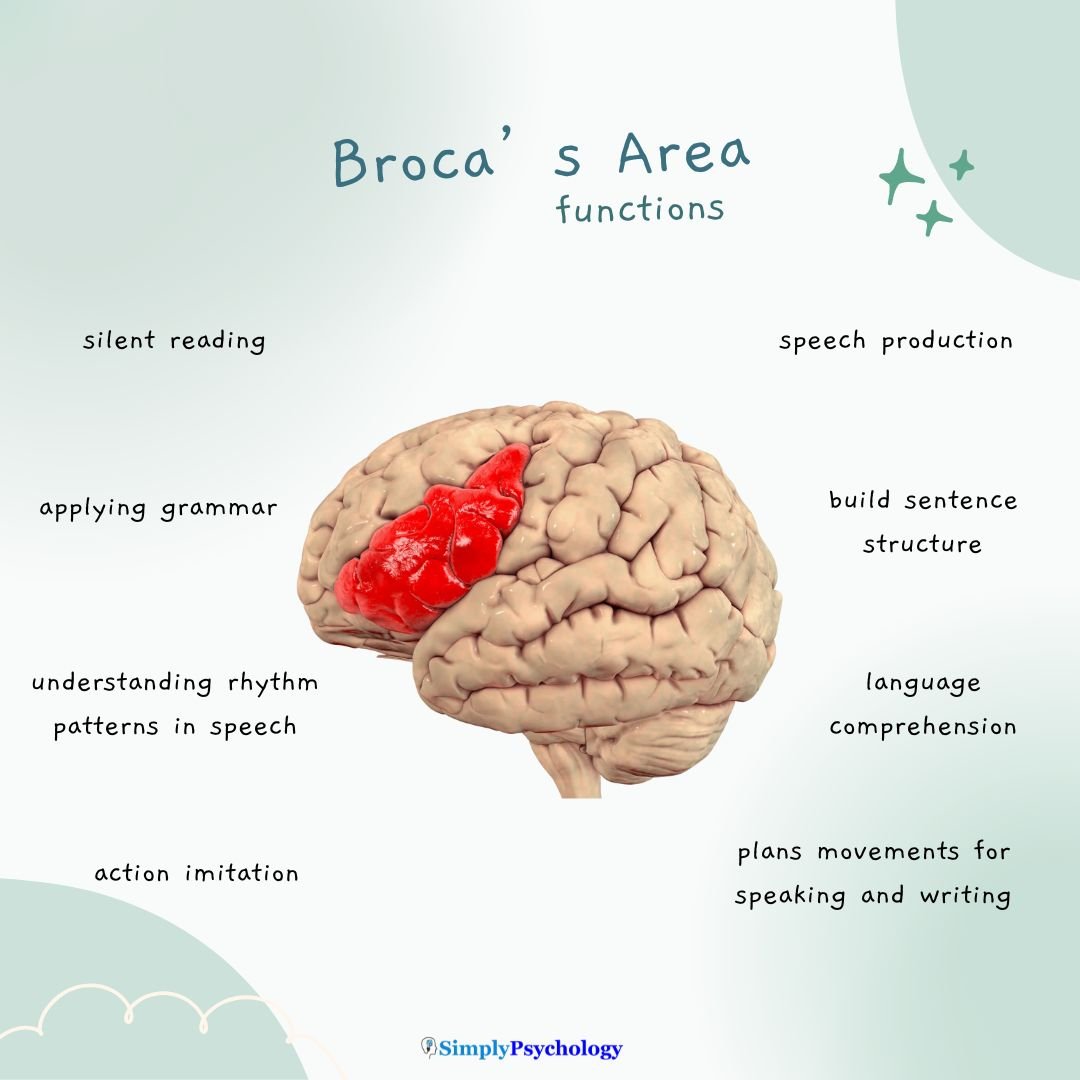Broca’s area is a small but vital region in the brain responsible for producing speech and processing language. Located in the left frontal lobe, it corresponds to Brodmann areas 44 and 45. Most people rely on this part of the brain to form words, construct sentences, and organize grammar. Without it, fluent communication becomes difficult.

Where Is Broca’s Area Located?
Broca’s area sits in the posterior part of the inferior frontal gyrus, typically in the left hemisphere.
This side of the brain controls language in about 97% of right-handed individuals and the majority of left-handed people as well.
The left hemisphere is known as the “dominant hemisphere” for language in most people.
Functions of Broca’s Area
Broca’s area plays a key role in:
- Speech and language production
- Language comprehension (especially grammar)
- Sentence structure and syntax
- Motor planning for spoken and written language
- Remembering verbal information
- Reading complex sentences
Research by Bookheimer et al. (1995) suggests Broca’s area is active during silent reading, indicating its role in internal language processing.
Nishitani and Hari (2002) showed that Broca’s area is also involved in rhythm processing and action imitation, linking language to motor and timing functions.
Some studies also suggest that Broca’s area contains mirror neurons, which fire both when we act and when we observe someone else doing the same action. This may explain its role in both speech and gesture-based communication (Nishitani & Hari, 2002).
Connections to Other Language Regions
Broca’s area is one part of a broader language network. It works closely with Wernicke’s area, which is responsible for understanding language.
These two areas are connected by a bundle of nerve fibers called the arcuate fasciculus.
This connection helps translate thoughts into coherent speech: Wernicke’s area finds the right words, and Broca’s area helps produce them aloud.
What Happens When Broca’s Area Is Damaged?
Damage to this region can result in Broca’s aphasia, a condition marked by:
- Difficulty speaking fluently
- Struggling to form grammatically correct sentences
- Repetitive or broken speech
- Understanding language better than producing it
- Abnormal tone or rhythm
For example, someone with Broca’s aphasia might want to say “I am going to the store” but instead say “go… store” with effort and frustration. Speech may be slow, halting, and limited to key words.
History of Broca’s Area
In 1861, French physician Paul Broca studied a patient named Louis Victor Leborgne, who could only say one word: “Tan.” Despite understanding others, he struggled to speak.
After Leborgne’s death, Broca examined his brain and found damage in the left frontal lobe. This was the first clear evidence that specific brain regions control specific functions—in this case, language production.
Broca studied more patients and found the same pattern: damage in the left frontal region consistently resulted in speech impairments.
His work laid the foundation for the idea of brain lateralization—that certain mental functions are localized in specific hemispheres.
Why Broca’s Area Matters
Broca’s area is central to how we express our thoughts in words. It coordinates mental ideas with physical actions, enabling fluent, structured speech.
Understanding this region not only helps clinicians treat language disorders but also gives us insight into how the brain turns thoughts into language.
References
Bauman, M. L., & Kemper, T. L. (2005). Neuroanatomic observations of the brain in autism: a review and future directions. International journal of developmental neuroscience, 23 (2-3), 183-187.
Bookheimer, S. (2002). Functional MRI of language: new approaches to understanding the cortical organization of semantic processing. Annual review of neuroscience, 25 (1), 151-188.
Bookheimer, S. Y., Zeffiro, T. A., Blaxton, T., Gaillard, W., & Theodore, W. (1995). Regional cerebral blood flow during object naming and word reading. /em> Human Brain Mapping, 3
(2), 93-106.
Chaplin, T. A., Rosa, M. G. P., & Yu, H. H. (2020). Scaling up the simian primate cortex: A conserved pattern of expansion across brain sizes. In Evolutionary Neuroscience (pp. 533-545). Academic Press.
Cooke, A., Zurif, E. B., DeVita, C., Alsop, D., Koenig, P., Detre, J., Gee, J., Pinãngo, M., Balogh, J. & Grossman, M. (2002). Neural basis for sentence comprehension: Grammatical and short‐term memory components. Human brain mapping, 15 (2), 80-94.
Gabrieli, J. D., Poldrack, R. A., & Desmond, J. E. (1998). The role of left prefrontal cortex in language and memory. Proceedings of the national Academy of Sciences, 95 (3), 906-913.
Guy-Evans, O. (2021, May 18). Lateralization of brain function. Simply Psychology.
Nishitani, N., & Hari, R. (2002). Viewing lip forms: cortical dynamics. Neuron, 36 (6), 1211-1220.
Nishitani, N., Schurmann, M., Amunts, K., & Hari, R. (2005). Broca’s region: from action to language. Physiology, 20 (1), 60-69.
FAQs
Broca’s area is located in which lobe of the brain?
Broca’s area is located in the frontal lobe of the brain, specifically in the left hemisphere for most right-handed individuals and a significant portion of left-handed individuals. This region is essential for language production and speech control.
What is the function of Broca’s area in the brain?
Broca’s area plays a key role in language development by supporting speech motor planning and articulation.
As children acquire language, Broca’s area develops to coordinate the complex mouth and vocal tract movements needed for fluent speech production.
Does Broca’s area only handle speech?
No. While it’s best known for producing speech, it’s also involved in processing grammar, verbal memory, and even some aspects of movement and gesture.


